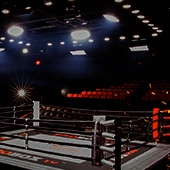by David P. Greisman
Last year started so well for Showtime.
Its first major boxing broadcast of 2015 crowned a new heavyweight titleholder when Deontay Wilder defeated Bermane Stiverne. The main event pulled in an average of more than 1.2 million viewers, the network’s second-highest rating for the sport in more than a decade.
The rest of the year wasn’t anywhere near as good. This year, however, is already looking like it could be much better.
Showtime recently announced eight upcoming broadcasts, seven of which will take place between April and June. Six of those eight shows will be on Saturdays on the network; the seventh will be a partnership with sister network CBS on a Saturday while the eighth is a Friday night episode of “ShoBox: The New Generation.”
By this summer, Showtime will have aired at least nine major Saturday night broadcasts — shows that aren’t “ShoBox.” That’s the same number it aired for the entirety of 2015. HBO, meanwhile, had 16 “World Championship Boxing” or “Boxing After Dark” broadcasts on Saturdays last year. (HBO’s ratings aren’t what they once were either.)
Last year, the week of Stiverne vs. Wilder had also brought a huge announcement: Al Haymon, the hugely influential boxing adviser whose stable had expanded to include an even greater number of titleholders, contender and prospects, launched a venture called “Premier Boxing Champions,” which beginning in 2015 has put on shows, many of which with purchased airtime, on a remarkable number of networks. It is aiming to increase boxing’s audience size, especially with broadcasts on free national networks CBS and NBC (and as of 2016, FOX), as well as widely distributed cable networks ESPN and Spike TV, plus other smaller channels.
Showtime, which worked closely with Haymon and his boxers before and has continued to do so, had known the news was coming.
“I expect to see all of those fighters back on Showtime very, very soon. We were part of the decision concerning which fights would go to NBC and we were consulted and we agreed with taking those individual fights to NBC. What we’re looking to do here is not about one or two good fights,” said Showtime executive Stephen Espinoza at the time in an interview with Lem Satterfield, then of RingTV.com and now a writer for Premier Boxing Champions.
“It’s about elevating the sport and expanding the sport and eventually drawing more fans of the sport and of those fighters to Showtime,” Espinoza said. “I’d like nothing more than for Adrien [Broner] and Keith [Thurman] and Robert [Guerrero] and Danny [Garcia] to get fans from among the millions of viewers of those telecasts and then, to bring all of those back to Showtime.”
Despite Showtime’s involvement and continued relationship, the news nevertheless had an effect on a network that had been on a roll in recent years, becoming the preferred home for a time for Golden Boy Promotions shows, which often featured Haymon’s stars. It had landed Floyd Mayweather Jr. in a landmark six-fight pay-per-view deal. Its cachet had risen. So had its ratings.
But Haymon concentrating on the investor-financed PBC pushed a lot of those stars away from Showtime, including bouts toward which Showtime had been building. (Golden Boy and Haymon had split with each other in a case settled via arbitration, and the promoter had since moved back to HBO.)
It wasn’t a lost year for Showtime. It still was part of the biggest pay-per-view in boxing history, raking in its share of revenue for Mayweather vs. Manny Pacquiao, and it produced and distributed Mayweather’s farewell pay-per-view against Andre Berto. It wasn’t getting many of the biggest fights on its main channel, though.
It did have Gary Russell Jr. capturing a featherweight title from Jhonny Gonzalez; light heavyweight Andrzej Fonfara making Julio Cesar Chavez Jr. quit; Wilder defending against Eric Molina; Chavez Jr. coming back against Marcos Reyes; Broner capturing a junior welterweight title against Khabib Allakhverdiev; super middleweight James DeGale defending his belt in a battle with Lucian Bute; Danny Jacobs making surprisingly quick work of fellow middleweight Peter Quillin; and Billy Joe Saunders picking up a middleweight belt from Andy Lee.
Even those bouts it did get weren’t doing very good ratings. Besides Stiverne-Wilder, no other show’s main event averaged more than 700,000 viewers, according to Nielsen estimates. Only three of them — Chavez’s two bouts and Wilder-Molina — pulled in around or above 50 percent of the Stiverne-Wilder rating.
Those couldn’t be considered big victories either. Wilder hadn’t retained much of his audience despite his formidable power and marketable personality. Chavez had come back from a lengthy layoff with less of a following. His previous appearance, which had been on HBO in 2014, drew nearly 1.4 million people.
Broner’s win over Allakhverdiev was his first appearance on Showtime in about 13 months. He’d averaged 852,000 viewers for a 2014 victory over Emanuel Taylor, then fought John Molina Jr. on the highly watched “PBC on NBC” debut, and then faced Shawn Porter in an NBC headliner that had an average audience of 2.4 million. Those were, respectively, a lackluster win and a lackluster loss that had preceded his return to Showtime.
There were other important potential caveats worth considering: Chavez-Fonfara, Wilder-Molina and Broner-Allakhverdiev all were aired on nights that HBO also had boxing. Other fights aren’t necessarily the only competing programming either. Those fights had peak audiences that were, by definition, larger than the average. Showtime has fewer subscribers than HBO. And the premium cable networks like to note that ratings aren’t the only number that matters for them; subscribers are what make them money.
Still, the ratings and sparser schedule suggested it wasn’t a great year. Two other shows in the final quarter of 2015 were canceled after Kell Brook and Gary Russell Jr. suffered injuries.
“I think we all knew that this would be a year of transition. And we weren't really sure what impact it would have,” Espinoza told Chris Mannix, then of Sports Illustrated and now of Yahoo! Sports, in a September interview. “But we're really six months into the PBC business model, so we're only now starting to really appreciate what the plan is. And it's starting to come a little bit full circle.”
He mentioned a handful of fighters he expected to be back on Showtime soon.
“So the Showtime perspective part of the experiment, so to speak, was always, ‘Let's see what happens when we allow some of our guys to go to other outlets and get a different type of exposure. What happens when they come back? What does that do for viewership? What does that do for their popularity?” Espinoza said in September.
“PBC was feeling its way. And there're other factors as well, from fights that we tried to make that couldn't be made, to schedule challenges on our own schedule to budgetary considerations,” he soon added in that interview. “There's a lot that goes on underneath the water level, to use the iceberg analogy, that isn't really apparent. So it's not quite as simple as to say the PBC took all out good fights and fighters away to other networks. Part of the plan was to allow those fighters to leave, but there are also other considerations that come up, too.”
So while Thurman-Guerrero, Garcia vs. Lamont Peterson and Leo Santa Cruz vs. Abner Mares were among the major fights to end up elsewhere, Showtime did get Daniel Jacobs vs. Peter Quillin this past December and had Wilder, who made one more defense in 2015 with an NBC appearance, back on premium cable against Artur Szpilka in January 2016.
Jacobs-Quillin averaged just 386,000 viewers. Wilder-Szpilka averaged 500,000 viewers, not including those who watched via Showtime’s free preview weekend and online simulcast. And Santa Cruz’s win over Kiko Martinez — aired on Showtime pretty much between HBO’s undercard and main event bouts that night — averaged just 297,000.
These coming months, then, will be telling. It also will be interesting to see what PBC shows will be announced soon. But for Showtime, their upcoming schedule includes:
- Charles Martin defending his heavyweight title in London on April 9 against contender Anthony Joshua, with a featherweight title bout on the undercard.
- Gary Russell Jr. defending against Patrick Hyland on April 16 in a bout that had been postponed when the Keith Thurman-Shawn Porter card originally scheduled for this past weekend was canceled due to Thurman getting hurt in a motor vehicle crash. A junior lightweight title bout is on the undercard.
- Badou Jack defending his super middleweight title against Lucian Bute on April 30 in a card also featuring 168-pound titleholder DeGale against Rogelio Medina.
- Wilder vs. Alexander Povetkin, possibly in May and potentially in Russia.
- Ruslan Provodnikov in what could be an exciting battle with John Molina Jr. on June 11.
- Santa Cruz defending his featherweight title against Carl Frampton, who is moving up after unifying belts at 122, in a bout expected to take place in late summer.
- Thurman-Porter, which has been rescheduled for June 25 in a CBS-broadcast card with which Showtime, as usual, will be involved.
This second wind from Showtime is bringing the network a strong run. This industry isn’t a sprint, however, but rather a marathon.
Then again, this really shouldn’t be a race. We boxing fans should want everyone to be moving with good strides and a strong pace.
Boxing’s most hardcore followers sometimes take sides in the rivalries between promoters and their counterparts or between the major networks. There also are those who root against Haymon because of his influence on the sport and what they feel that has meant.
It is best if everyone does well — to an extent. We should want good fights, compelling action or drama, or at least our heroes and favorites coming out triumphant. Despite the theme of this column, we are fans of the sport of boxing first and foremost. That just means we follow, observe and remark upon the business of boxing, for what happens outside the ring so often has an effect on what does or doesn’t happen inside of it.
We can and should still speak with our wallets and remote controls.
The decisions that we make in these coming months will give an indication as to which direction Showtime’s second wind is blowing — and whether we will have rewarded their efforts by putting wind in their sails.
“Fighting Words” appears every Monday on BoxingScene.com. Pick up a copy of David’s book, “Fighting Words: The Heart and Heartbreak of Boxing,” at http://bit.ly/fightingwordsamazon or internationally at http://bit.ly/fightingwordsworldwide. Send questions/comments via email at fightingwords1@gmail.com



